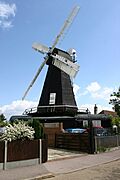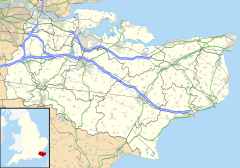Herne, Kent facts for kids
Quick facts for kids Herne |
|
|---|---|
 Herne Windmill |
|
| Population | 7,325 (2001) (parish) |
| OS grid reference | TR181658 |
| Civil parish |
|
| District | |
| Shire county | |
| Region | |
| Country | England |
| Sovereign state | United Kingdom |
| Post town | HERNE BAY |
| Postcode district | CT6 |
| Dialling code | 01227 |
| Police | Kent |
| Fire | Kent |
| Ambulance | South East Coast |
| EU Parliament | South East England |
| UK Parliament |
|
Herne is a village in Kent, England. It is located in the Canterbury area. A major road, the Thanet Way, separates Herne from the seaside town of Herne Bay.
Close by, you can find the former small village of Hunters Forstal, located between Herne and Broomfield. Herne Common is to the south, on the A291 road. The tiny village of Bullockstone is also nearby, about one mile to the west.
Contents
Exploring Herne's Past
Ancient Church Discoveries
In 1976, archaeologists dug inside St Martin's Church in Herne. They found that the first church building was very old. It was similar to early Anglo-Saxon churches in Kent. These old churches often had a main hall called a nave and a rounded end part called an apsidal chancel.
A historian named Nicholas Brooks thought this church might have been a "minster." A minster was an important church in early England. It served a large area and often had priests living there. This minster might have been built as early as the 7th or 8th century. It could also have been built in the 10th century. This was a time when people were rebuilding after Viking attacks.
Until 1310, the church at Herne was a "chapelry." This meant it was a smaller church connected to a bigger one, St Mary's Church in Reculver. After 1310, it became its own parish church. A parish church serves a specific local area.
Important People and Places
In the 1400s, a man named Matthew Phillip lived near Herne. He became a successful goldsmith in London. A goldsmith is someone who makes things from gold. He even became the head of the goldsmiths' guild. A guild was like a club or union for people who did the same job. Matthew Phillip was also the Lord Mayor of London from 1463 to 1464. This was a very important job, like being the mayor of a huge city today.
Matthew Phillip owned a large house called Hawe Manor, close to Herne. His second wife, Christina, was likely buried in a special chapel at the church. A brass plaque was placed there to remember her in 1470.
Later, Hawe Manor was home to John Fineux. He was the Lord Chief Justice of the King's Bench. This meant he was a very important judge in England from 1495 to 1526.
In 1538, Nicholas Ridley became the "vicar" of Herne. A vicar is a type of priest in the Church of England. He was chosen by Archbishop Thomas Cranmer. An Archbishop is a very senior leader in the church. Cranmer often stayed at Ford Palace nearby. Ridley and Cranmer worked together on important religious ideas. These ideas later became part of the "Forty-two Articles of Religion." Ridley remained the vicar until 1550.
What Herne Offers Today
Herne has schools for young children. There is an infant school and a junior school. The village also has a post office. This is where people can send letters and packages.
For adults, there is a special type of small pub called the Butchers Arms. It opened in Herne in 2005.


